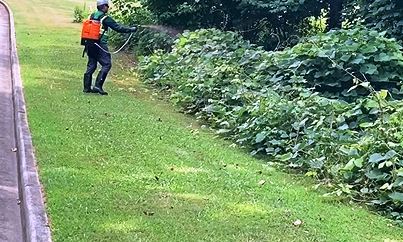
Tall weeds obstruct traffic signs and impair visibility on curves. Ideal treatment allows native grasses to flourish while targeting invasives.

The primary objectives for the maintenance of Utility, Right of Way and D.O.T. Roadside Vegetation Management are often overlooked by the public. And that's ok with us, Our nonintrusive Right of Way Vegetation Program execution supports Cities, Counties, Watershed Authorities and Utilities.

Tall weeds obstruct traffic signs and impair visibility on curves. Ideal treatment allows native grasses to flourish while targeting invasives.

Preservation of Infrastructure. Power, Natural Gas, Oil Pipeline, Emergency Access. Treated Rights of Way Prevent Restoration Delays.

Contributing to the Safety of Local Residents & Industry Personnel alike. Controlling vegetation via Selective & Non Selective Control.

Enhancement and Preservation of the natural aesthetic quality of the Roadside with Vegetation Management and the right plants.
Right of Way Herbicide Programs provide control of vegetative growth for Utility Access, Rights of Way, Industrial Sites, Rail Routes and Government Land.
Our experienced Crews of Licensed Applicators utilize a comprehensive inventory of state of the art Equipment. This allows us to deliver highly targeted precision applications, lowering maintenance costs for the communities we serve.
A controlled roadside ecosystem is critical. Road Shoulder treatment prevents erosion of the road surface by killing and preventing the encroaching unwanted vegetation, grass and weeds. All work is done per the program's Scope of Work.
Aggressive vines, thorny brush, and noxious weeds are killed minimizing grass damage, which better filters sediment from road surface water runoff, protecting surrounding land and streams from vehicle fluids.
Brush control programs eliminate thorny & woody brush and small trees from the road edge. Width of treatment swath is defined depending on the Government Right of Way customer agency. Applications include Noxious Weed Killer, Signpost base, and Guardrail linear spraying.
Applicators utilize Herbicide Mix consisting of one or more of the following: Accord, Escort, Arsenal, Garlon, Imazapyr. The final chemical selection and dilution is the responsibility of the VegClear team with input from the procuring Government Agency.
As an Approved Herbicide Contractor, VegClear is licensed by the State Department of Agriculture. Products are applied in strict conformance to manufacturer label and environmental regulations. Additionally, it is done at the lowest feasible rate to achieve target results and prevent resistance.
At VegClear, we understand the strategic sourcing models used by both government bodies and industry. This allows procurement teams to choose a supplier that closely matches their service needs and fits into the agency or company's overall strategies and long-term goals.
We participate in a variety of procurement processes to deliver results and necessary services to our corporate and government clients, including standard request for proposal (RFP) submittals, as well as other RFx protocols such as request for bid (RFB), request for information (RFI), request for quotation (RFQ), and request for tender (RFT). We also handle straight bid, reverse auctions, and negotiated agreements.
In order to ensure the best delivery of services, it's important for us to understand the primary needs and criteria of the procuring agency in advance of vegetation management bid submission. This includes factors like the total cost of ownership (TCO) model, value-added opportunities and preference, first cost decision authority, safety priority factors, and our environmental commitment to service delivery. We also take into account the importance of our ability to serve our clients as an e-enabled business.
Environmental Factors, Certifications and Process.
Protected Land, Herbicide Restricted, Sensitive Wildlife
Local Population, Municipal Scrutiny and Overlay Districts.
Program Preference for SMB, SBA, HUB, UPB, etc.